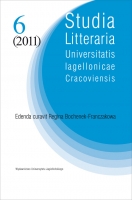Lord Byron and the Metamorphoses of Polidori’s Vampyre
Lord Byron and the Metamorphoses of Polidori’s Vampyre
Author(s): Monika CoghenSubject(s): Literary Texts
Published by: Wydawnictwo Uniwersytetu Jagiellońskiego
Keywords: Lord Byron; Polidori; vampire; vampiric character; byromania; Byron’s reception in Poland; nineteenth-century literature; English Literature
Summary/Abstract: The aim of this article is to investigate the links between vampire stories and plays and Lord Byron in the context of his early nineteenth-century reception in Europe, and particularly in Poland. Byron is often regarded as one of the main originators of vampire stories in modern European culture and occasionally even as a model for vampiric characters. This image of Byron was mainly constructed on the basis of a passage in The Giaour and John Polidori’s tale The Vampyre, which had first been erroneously attributed to Byron. Owing to Byron’s literary fame as the greatest living British poet as well as to his scandalous reputation, The Vampyre gained great popularity both in Britain and on the Continent, which resulted in numerous theatrical adaptations, especially in France and in Germany. In Poland the French melodrama Upiór (Le Vampire) by Charles Nodier, Pierre Carmouche and Achille de Jouffroy was a great stage success and was published in a book form. Polidori’s tale allegedly originated in Byron’s idea, the record of which appears in the fragment called “Augustus Darvell”. Echoing the techniques Byron used to suggest to his readers that he himself might be identified with the protagonists of his poetic tales, Polidori similarly invites the reader to identify his eponymous vampire Lord Ruthven with Lord Byron. In Byron’s fragment one can trace only a hint of vampirism; in Polidori’s story it becomes a metaphor not only of sexual profligacy but also of “byromania”, the cult of Byron among his female readers. In popular melodrama the vampire character is conflated with Don Giovanni from Mozart’s opera, possibly because of Byron’s publication of the first two cantos of Don Juan.
Journal: Studia Litteraria Universitatis Iagellonicae Cracoviensis
- Issue Year: 2011
- Issue No: 6
- Page Range: 29-40
- Page Count: 12
- Language: English

